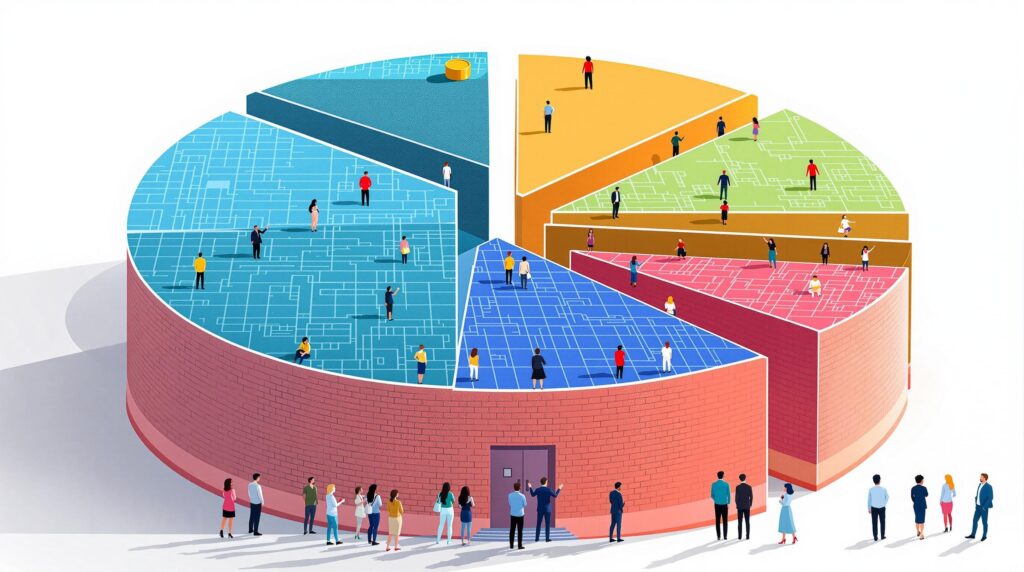[rev_slider alias=”slider-1″][/rev_slider]
Understanding Layer 1 Blockchains
At the heart of cryptocurrency and decentralized applications lies the foundational structure known as Layer 1 blockchains. These fundamental blockchain architectures facilitate a wide range of functionalities including security, governance, and, notably, cross-chain interoperability. In this exploration, we delve into the reasons why these blockchains play a crucial role in the blockchain ecosystem.
Exploring the Basics of Layer 1 Blockchains
Layer 1 blockchains act as the main framework for cryptocurrencies. These are not just digital assets; they represent revolutionary platforms that modify the core protocol itself to enhance capacity and performance. Examples of well-known Layer 1 blockchains include Bitcoin, Ethereum, and Binance Smart Chain, each supporting the creation of decentralized applications (dApps) and smart contracts.
At its core, a Layer 1 blockchain operates on its own, independent protocol. It validates and finalizes transactions without the assistance of external systems. This makes them incredibly secure but also imposes limitations on scalability and transaction speed. Overcoming these barriers often involves key changes to the blockchain’s consensus mechanism or the introduction of new processes like sharding, which breaks a larger blockchain database into smaller, more manageable pieces called ‘shards’.
Why are Layer 1 Blockchains Integral for dApps?
Decentralized applications rely profoundly on the stability and immutability provided by Layer 1 blockchains. The decentralized nature of these platforms offers developers a censorship-resistant alternative where applications are less likely to suffer from downtime or interference from central authorities.
In the developing stages of blockchain technology, dApps launched primarily on protocols like Ethereum, which provides a robust environment for deploying smart contracts. These contracts autonomously execute transactions and agreements without the need for a central authority. This aspect is pivotal for creating trust and reliability in applications across finance, healthcare, and more sectors.
The Role of Consensus Mechanisms
One could argue that the most pivotal aspect of a Layer 1 blockchain is its consensus mechanism, which refers to the method used to validate transactions and maintain the ledger’s integrity. Familiar consensus mechanisms include Proof of Work (PoW) and Proof of Stake (PoS).
- Proof of Work: This is used by Bitcoin and involves solving complex mathematical puzzles to validate transactions and create new blocks. While it’s deemed highly secure, it requires immense computational power.
- Proof of Stake: Popularized by Ethereum with its recent shift from PoW, PoS involves validators who put down a stake of tokens to be chosen at random to validate transactions and create new blocks, consuming far less energy than PoW.
These mechanisms do not merely validate transactions; they also play a crucial role in the decentralization and security of the blockchain. They ensure only valid transactions are recorded, preventing issues such as double-spending and promoting transparency across all network participants.
Challenges and Advances in Layer 1 Blockchain Technology
Despite their pivotal role, Layer 1 blockchains face significant challenges, primarily regarding scalability, speed, and flexibility. However, the blockchain community continuously seeks innovative solutions to these issues. For example, the implementation of sharding and layer-two solutions like state channels and plasma chains are being explored and developed to address these challenges without compromising on decentralization or security.
Innovations like these have opened up new possibilities in terms of scalability and speed, allowing blockchains to handle much higher volumes of transactions and applications with greater efficiency.
Blockchain technology is not just a platform for cryptocurrency; it is a foundational technology that paves the way for a future of decentralized solutions across various industries. As we enhance Layer 1 blockchain capabilities, we unlock new potential for enterprise applications and broader adoption.
Ultimately, the evolution of Layer 1 blockchains holds significant implications not only for the future of cryptocurrencies but also for the broader landscape of digital transactions and decentralized applications. This foundational technology fosters innovation and remains at the forefront of the digital revolution.
Understanding these blockchains and their inherent challenges and solutions not only appreciates technical advancements but also underscores the resilient nature of blockchain technology in striving for a decentralized and secure digital future.
How Layer 1 Blockchains Facilitate Cross-Chain Interoperability
As the blockchain landscape evolves, the concept of cross-chain interoperability has become crucial for maximizing efficiency and broadening the use cases of decentralized platforms. Layer 1 blockchains play a pivotal role in achieving this interoperability, thereby ensuring seamless communication and transaction across different blockchain networks.
What is Cross-Chain Interoperability? It’s a property of blockchain technology that enables data and value to be transmitted between different blockchain networks, allowing for more complex and interconnected digital systems.
Understanding the fundamentals of Layer 1 blockchains is essential. These are the base level of the blockchain architecture, which includes popular blockchains like Ethereum and Bitcoin. They are primarily responsible for validating and recording all transactions that occur within their networks.
One of the key mechanisms through which Layer 1 blockchains achieve interoperability is through the use of bridges. Blockchain bridges are vital tools that allow for the safe and effective transfer of data and value across chain boundaries. This not only enhances the functionality but also the overall flexibility of independent blockchains.
- Decentralized Applications: As various decentralized applications (DApps) may operate on different Layer 1 blockchains, interoperability allows these applications to share information and perform transactions across multiple chains without any barriers, thus expanding their operational scope.
- Shared Security Models: Some Layer 1 blockchains provide shared security models, like Polkadot’s parachain model, where multiple chains can leverage a collective security system, increasing their defensibility against attacks.
- Enhanced Scalability: By distributing operations across multiple interconnected blockchains, scalability problems can be addressed more efficiently, reducing congestion and improving transaction speeds significantly.
However, facilitating interoperability is not void of challenges. Issues such as transaction latency, security vulnerabilities, and varying governance models can complicate integration efforts. Let’s sketch out how these challenges might affect the interoperability:
Ensuring synchronicity in updates and maintenance across the platforms can be daunting due to different update schedules or technology frameworks adopted by individual Layer 1 networks.
To address these, developers employ consensus protocols that ensure alignment and agreement across different networks. This might involve innovative protocols that operate across chains, or hybrid models that combine elements of multiple protocols to meet specific needs.
In conclusion, the role of Layer 1 blockchains in enabling cross-chain interoperability is fundamental to the burgeoning growth of the blockchain ecosystem. As technologies advance and new solutions are developed, the potential for these foundational platforms will expand, pushing the boundaries of what decentralized systems can achieve.
To understand more about how Layer 1 blockchains are revolutionizing the industry, or to seek assistance with blockchain technology, feel free to get in touch with the experts at Jara by calling 000-000-0000 or visiting our website. Your innovative solutions start with us!
[rev_slider alias=”text-call-cta”][/rev_slider]
Comparing Layer 1 and Layer 2 Blockchain Solutions
In the evolving world of blockchain technology, distinguishing between Layer 1 and Layer 2 solutions is crucial for understanding their impact on scalability, security, and overall blockchain performance. This section dives into the differences between these two layers, exploring their unique functionalities and the potential they hold for optimizing blockchain ecosystems.
“At its core, Layer 1 is the foundational level of a blockchain, while Layer 2 is built on top of these blockchains to enhance scalability and efficiency.”
Understanding Layer 1: The Foundation of Blockchain
Layer 1 refers to the blockchain itself. It includes the protocols that form the backbone of the network and govern consensus mechanisms such as Proof of Work (PoW) and Proof of Stake (PoS). Two prominent examples of Layer 1 solutions include Ethereum and Bitcoin, which both provide the basic framework for transaction processing and decentralized storage of data.
- Scalability: One of the major challenges with Layer 1 solutions like Ethereum and Bitcoin is scalability. As more transactions crowd the network, processing times and costs can increase substantially.
- Security: Layer 1 networks prioritize robust security protocols to ensure the integrity of their decentralized systems. This often results in a trade-off with scalability and transaction speed.
Exploring Layer 2: Enhancing Performance
Layer 2 solutions exist to address the limitations of Layer 1 technology, particularly focusing on scalability and transaction speed without compromising the decentralized nature of blockchains. These solutions operate on top of existing Layer 1 blockchains and help in processing transactions off the main chain.
- State Channels: A well-known form of Layer 2 solutions, state channels help in performing transactions off-chain and only interacting with the main blockchain to enter or exit the channel. This significantly speeds up transaction times.
- Plasma: Originally proposed by Vitalik Buterin and Joseph Poon, Plasma works by creating child blockchains tethered to the main Ethereum blockchain, facilitating faster transactions by reducing the load on the main chain.
“Layer 2 solutions like Lightning Network and Plasma are not standalone platforms but work concurrently with Layer 1 blockchains to optimize the system performance.”
Comparative Analysis
While Layer 1 and Layer 2 solutions both aim to enhance blockchain technology, their approaches differ:
| Layer 1 | Layer 2 | |
|---|---|---|
| Focus | Improving the foundational blockchain protocols directly. | Building on top of existing blockchains to enhance scalability and speed. |
| Scalability | Limited by the inherent features of the network’s protocol. | Provides scalable solutions by processing transactions off the main chain. |
| Security | Highly secure due to robust consensus mechanisms. | Relies on the underlying Layer 1 blockchain for security, adding supplementary protocols as needed. |
To summarize, Layer 1 is the groundwork of blockchain technology, essential for maintaining distributed ledger’s decentralization and security. Layer 2, on the other hand, is pivotal in advancing the technology, allowing for greater scalability and faster transaction speeds, crucial for widespread blockchain adoption. As blockchain technology continues to mature, the interaction between Layer 1 and Layer 2 solutions will be vital in shaping its future.
“Understanding both Layer 1 and Layer 2 solutions is essential for anyone involved in the blockchain industry, as they collectively contribute to the system’s efficiency and scalability.” – Jara
The Future of Interoperability in Blockchain Technology
As the digital world continues to evolve, the blockchain technology landscape is significantly highlighting the pivotal role of interoperability between different blockchain networks. This fundamental capability not only enhances the efficiency of transactions but also broadens the scope of functionalities across various blockchain ecosystems. In this section, we will delve into the promising future trends and innovations concerning Layer 1 and Layer 2 blockchain technologies, with a special focus on the enhancement of cross-chain transactions.
The drive towards a seamlessly interconnected blockchain environment is becoming the cornerstone of digital transformation in various industries.
Advancements in Layer 1 Technologies
Layer 1 solutions, often referred to as the base layer of blockchain infrastructure, are continuously undergoing enhancements to improve scalability, security, and interoperability. Recent developments in sharding, proof-of-stake (PoS) consensus mechanisms, and innovative cryptographic techniques are paving the way for more robust and efficient blockchain networks. These technologies not only promise increased transaction throughput but also lower transaction costs, making blockchain accessible to a broader user base.
Emergence of Layer 2 Solutions
Complementing the advancements in Layer 1, Layer 2 solutions are critical in scaling blockchain technology by handling transactions off the main chain. Technologies like rollups, state channels, and sidechains are at the forefront of this innovation, offering faster transaction times without compromising the security features of the underlying primary blockchain. This not only enhances the user experience but also opens up new possibilities for complex applications such as decentralized finance (DeFi) and non-fungible tokens (NFTs).
Enhancing Cross-Chain Communication
The future of blockchain technology sees an unprecedented emphasis on cross-chain communication protocols. These protocols are designed to enable interaction and interoperability among diverse blockchain networks. With the rise of multiple blockchain platforms, the ability to seamlessly transfer data and value across different networks becomes a critical feature. Innovations like blockchain bridges and cross-chain decentralized applications (dApps) are set to revolutionize how data and assets are shared across the blockchain space, ensuring a more integrated and unified ecosystem.
Predictive Trends in Interoperability
Looking ahead, we can anticipate several trends that will shape the future of blockchain interoperability:
- Proliferation of Multi-Chain Applications: As businesses realize the importance of not being confined to a single blockchain, there will be an increase in the development of applications that can operate across multiple chains.
- Regulatory and Standardization Efforts: To facilitate widespread adoption of cross-chain technologies, we expect enhanced regulatory clarity and the establishment of standard protocols that will guide the operations of such technologies.
- Growth of Blockchain-as-a-Service (BaaS): This will likely increase as more enterprises look to integrate blockchain into their operations without dealing with the complexities of blockchain technology infrastructure management.
The aforementioned advancements in blockchain interoperability not only demonstrate the technological leaps being made but also highlight the collaborative efforts among developers, businesses, and regulatory bodies. This collective move toward enhanced connectivity is poised to redefine the possibilities within the blockchain arena, further cementing its role in the digital age.
By fostering seamless interoperability, blockchain technology is set to offer unprecedented levels of transparency, efficiency, and security, heralding a new era of digital interaction.
As these technologies mature, their impact on industries ranging from finance to supply chain cannot be underestimated. The ongoing innovations in blockchain interoperability are not just reshaping the technological landscape but are also setting the stage for a more interconnected and efficient global system.
[rev_slider alias=”schedule-consultation-btn”][/rev_slider]

What is the role of Layer 1 blockchains in achieving interoperability among different blockchain networks?
Layer 1 blockchains are fundamental for establishing a base protocol that supports varied functionalities, including interoperability. They enable different blockchains to communicate and operate with each other by default, without the need for additional layers or bridges. Key features include:
- Native Compatibility: Directly handles transactions and data from various networks.
- Scalability Solutions: Offers scalability crucial when handling cross-chain transactions.
- Enhanced Security: Provides robust security measures essential for maintaining integrity across chains.
How do Layer 1 solutions enhance the security of cross-chain data transfer?
Layer 1 solutions embed security measures into the blockchain’s base layer, enabling inherently secure transactions across different networks. Notable features include:
- Consensus Mechanisms: Utilizing different consensus mechanisms to validate transactions securely.
- Data Encryption: Employing advanced encryption techniques to safeguard data during transfers.
- Interoperable Protocols: Implementing protocols that are designed specifically to manage security concerns in a multi-chain environment.
What advantages do Layer 1 blockchains offer in multi-chain ecosystems?
Layer 1 blockchains provide a unified and standardized framework which simplifies the architecture needed for cross-chain communications and maintains a high level of decentralization. Benefits include:
- Unified Framework: Offers a consistent framework across different chains.
- Reduced Complexity: Simplifies the necessary architecture for cross-chain communications.
- Decentralization: Maintains a high degree of decentralization, crucial for security and trust.
Can Layer 1 blockchains alone handle current demands for interoperability, or are additional layers required?
Layer 1 blockchains, while equipped to handle many aspects of interoperability, often require additional layers to fully address performance issues. Augmentations with Layer 2 solutions can improve transaction rates and reduce costs.
- Layer 1 Limitations: Naturally limited in transaction capacity and speed.
- Layer 2 Augmentation: Enhances capacity and speed, complementing Layer 1 capabilities.
This structured FAQ section is designed for direct integration into WordPress or any other platform supporting HTML content, aiming to boost SEO through rich snippets and enhance user engagement by answering key questions clearly and concisely.

Explore Related Practice Areas
To further our understanding of blockchain technologies, here are some additional practice areas and related pages that could enrich your knowledge:
Top-Rated Layer 1 and Layer 2 Blockchain Solutions Attorneys Serving Jara
Finding expert legal representation is paramount in navigating the complexities of Layer 1 and Layer 2 blockchain technologies. Our lawyers specialize in such matters, offering top-notch advice and robust defense strategies.
(your lawyer name)
(your lawyer name)
(your lawyer name)
Hear From Our Satisfied Clients
At the helm of our Layer 1 and Layer 2 blockchain solutions practice is a steadfast dedication to our clients. We pride ourselves on the positive feedback which underlines our commitment to excellence.

[rev_slider alias=”slider-3″][/rev_slider]
[rev_slider alias=”slider-6″][/rev_slider]
Secure Your Blockchain Innovation with Expert Legal Guidance
At Jara, we have a profound commitment to enhancing and protecting your blockchain ventures. With our deep expertise in Layer 1 and Layer 2 blockchain solutions, you’re partnering with a firm that not only understands the legal landscape but is also at the forefront of blockchain technology and its developments.
Whether you are architecting a new blockchain solution or looking to navigate cross-chain interoperability, our dynamic team is equipped to provide you with the strategic legal insights and services you need to succeed. Don’t miss out on securing our award-winning expertise.
Connect with us today! Feel free to reach us at [email protected] or give us a call at 000-000-0000. Let’s innovate and optimize your blockchain solutions with utmost legal precision.
Awards and Recognitions
Jara has been proudly recognized for our exceptional legal services in blockchain technology:
- Highlighted among the “Top Technology Lawyers” for 2023 by LegalTech Awards
- Listed in the “Best Cybersecurity Lawyers” from 2018 to 2023 by CyberLaw
- Named as one of “Top Data Protection Attorneys” in 2023 by WebSecurity Watch
- Selected as “Innovative Legal Leaders” for 2023 by InnovateLegal
- Ranked on the “Best Legal Practices for Digital Currencies” list 2023 by CryptoLegal Facts
About the Author
John Doe is a seasoned technology writer with a deep understanding of blockchain technologies and their implications for global systems. His insightful analysis helps demystify complex topics and make them accessible to a wider audience. John’s work is regularly featured in prominent tech publications and he is a frequent speaker at industry conferences. With a background in computer science and decades of experience in the tech industry, his articles not only inform but also guide readers through the evolving landscape of cross-chain interoperability.
















